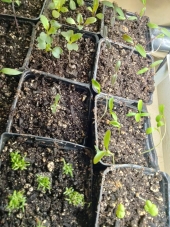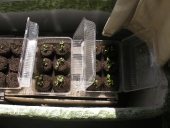So this is my third season using soil blocks, and last year I had a stellar year utilizing them... easily the best starts and best garden I've had, thanks to permies!
This year, luck seems to be against me and I've lost a good share of the seedlings I've started. Those that did make it have grown very very slowly and are way behind. The previous two seasons I was utilizing a slightly different recipe, but ran across Eliot Coleman's official one from his book and figured it would be more beneficial.
Last year, my recipe looked roughly like this:
* 1 part peat
* 1 part
compost (the one with a cow on the front from Home Depot)
* 1 part play sand
* sprinkle of homemade bone meal, which was boiled, cooked/dried and blended down to a powder.
This year, I used something closer to Coleman's recipe for the 2-inch blocks:
* 3 parts peat
* 2 parts compost
* 2 parts play sand
* 1 part garden soil
* Fertilizer mix, comprised of equal parts vermicompost, bone meal (as above), blood meal, fish emulsion, garden lime
All were fresh bags opened right before I mixed them. I did not sterilize the soil; have never had to before.
The 3/4 blocks I used his recipe with mostly filtered peat and no fertilizer mix. Of course, no fungus issues on those.
What happened is tri-fold:
* Seeds planted directly in the 2-inch blocks, but covered, failed to germinate. I had about a 10% germination rate on cauliflower, collards, peppers. Fresh seeds. I switched to using the 3/4 uncovered method. For squash I left these uncovered in the 2 inch, and had great germination, but still fungus I controlled immediately.
* Seeds planted in the 3/4 inch blocks sprouted well and hand no fungus, but seemed to have a hard time rooting properly and have sort of "languished" on the surface. I had better initial germination rates by not covering them as I did before, but they seem to fail to establish properly and grew very slow.
* Seedlings transplanted into the 2 inch blocks from the 3/4 inch died within 24 hours. Within 12 hours, I had an incredibly thick white fuzzy fungus, which looks like saprophytic fungus, but resulted in severe and immediate dampening off for alot of the transplants.
The process I followed:
*Mix up the soil and immediately use. Containers were washed with soap + water in advance.
*For soil blocks, I tried using chamomile tea to wet the soil to make the blocks, hoping to prevent the fungus from starting. No joy.
*The soil blocks are just wet enough to hold together.
*For seeds, planted and then put on temperature controlled heat mats on the floor (~75 degrees). Use a small fan for air circulation.
*For seedlings, immediately transplant into the soil and put back under grow lights. Circulate air with fan.
I've had some success using chamomile, cinnamon and peroxide to combat the fungus, but often its too late. An example of the blocks attached.
Has anyone run into this problem and identified what needed to be done to prevent this from happening? Is there something in the fertilizer mix that may have caused this, such as fish emulsion or vermicompost?

 2
2




 7
7




 3
3




 9
9






 8
8





 1
1








 1
1





 1
1





















